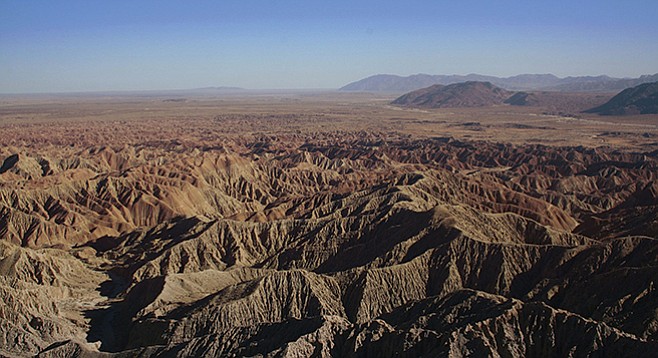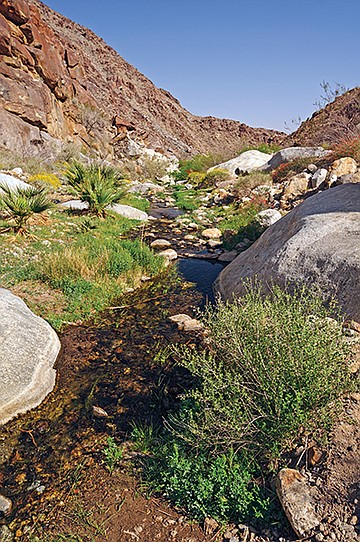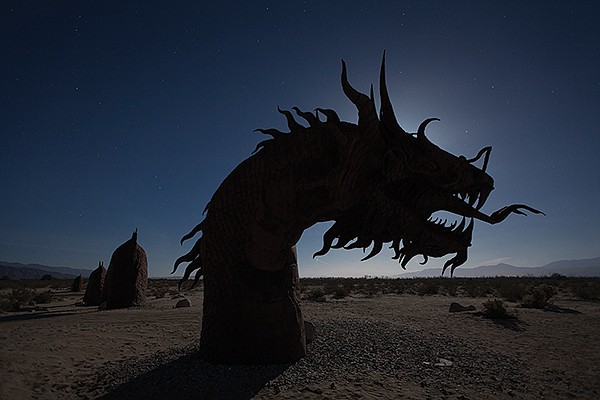 Facebook
Facebook
 X
X
 Instagram
Instagram
 TikTok
TikTok
 Youtube
Youtube

On January 26, San Diego County’s water authority exulted that the drought was over. On March 22, the New York Times wrote, “We have some good news on the California drought.” The huge snowpack in the Sierras portends more water. Countywide, San Diego’s reservoirs are filling up. People are cheering.

But there’s little joy in tiny Borrego Springs, in the northeast portion of the county. It doesn’t have reservoirs. It gets its water from an aquifer, or permeable rock that can transmit groundwater. It once considered buying water stored in county reservoirs, transporting it via a long pipeline, but that would have been too expensive.
In recent months, Borrego rainfall has been running 137 percent of the average, but how much of that water gets into the aquifer “is hard to quantify. It’s still a mystery,” says Geoff Poole, general manager of the Borrego Water District. Borrego is working with the United States Geological Survey to come up with a model that can estimate how much rainwater winds up in the aquifer.

Some Borregans are celebrating the rains, but scientists aren’t: “A few people have their heads buried in the sand, thinking everything is fine,” says James Dice, reserve manager for the Steele/Burnand Anza-Borrego Desert Research Center, run by the University of California Irvine. “At least half [realistically favor] cutting back on water use.”
The author of the Borrego Water Underground, a publication that has been warning the town of its water problem for a long time, flays the “overweening, hedonistic, self-interest” of a citizenry whose motivation is making a buck instead of protecting the environment. The purpose of the unsigned publication is to warn residents and potential residents and businesses “of the dire and rapidly deteriorating groundwater situation in the Borrego Valley.”
Some politicians representing Borrego aren’t helping: “Fifth District County Supervisor ‘Bulldozer Bill’ Horn is radically pro-development and openly and adamantly opposed to county involvement in managing groundwater.”
For a long time, Borrego has been drawing 19,100 acre-feet a year from its aquifer, and the inflow is only 5700 acre-feet. (One acre-foot equals 326,000 gallons, or enough to cover an acre with one foot of water.) To comply with state laws, by 2020 Borrego has to come up with a plan to match outflow and inflow. Then it will have 20 years to put the plan into action.
Borrego has about 3500 people, half of whom vamoose in the summer, when the temperature reaches 107 degrees or higher. (It hit 122 on June 25, 1990, and 122 on June 20 of last year.)
It is a tourist town surrounded by Anza-Borrego Desert State Park, the largest state park in California. Hikers, bikers, birders, golfers, and lovers of deserts, mountains, and wildflowers flock to Borrego. There are more than 100 large sculptures of animals that once lived in the area and some that still do.
But some tourists and part-time residents are losing enthusiasm, and water is a major reason. San Diegans tell me of their disappointment: “I love Borrego and visited three times the past nine months. I never travel without bottled water because many areas have nasty-tasting tap water, which often smells of sulfur,” says Reenie Shea.
“The water in Borrego now tastes terrible,” says Don Jones, who goes to Borrego each year with his wife. “I don’t remember that being a problem two or three years ago, but now I say it tastes like horse piss.”
“I have a home in Borrego Springs and spend about 40 percent of my time [t]here,” says David Lewis. “I have no problems with the water, but my wife does.”
The water quality depends greatly on the water’s location in the aquifer, says Kathy Dice, superintendent of Anza-Borrego Desert State Park and wife of James Dice. The aquifer has three levels. “The really good layer is the top one. The middle is a bit more mineralized. In the lowest level there has to be treatment,” she says.
Kathy Dice is on the advisory committee trying to come up with a plan to match inflow and outflow. “If we fail to do that, the state steps in and we go to court,” she says. “We have been in overdraft since the 1960s, when people first came here; they would dig a well and within a few feet get water. It gave the impression the water was unlimited.” Farms sprung up in the area, and now they use 70 percent of the water. It wasn’t until the 1980s that Borrego realized the water situation was critical.
Says Poole about the citizens’ group seeking a solution, “The very existence of our community depends on what we are working on. Nobody else is in our position.”
An obvious solution is to shut down farms; that is already happening. “One of the strategies is to fallow land,” says Poole. A large water user, such as a golf course, pays to fallow farmland and gets a water credit.
If Borrego doesn’t come up with a sustainability plan, water could become so expensive that people, businesses, and farms “could be forced out,” says James Dice.
Borrego’s water situation could do two things to real estate values: optimists who think the rainfalls are boosting the town’s future might pay more for homes than they would have during the drought. Contrarily, those educated on the reality might be less willing to pay for Borrego homes. Actually, home prices have been rising moderately. However, David Cragoe, broker-owner of Road Runner Realty, doesn’t think prices are rising because of the rain. Those values were going up before the rainfall. “People are feeling better about the economy and have more equity in their [coastal and inland] homes,” he says. So they are buying more second homes in Borrego.
Through recent decades, Borrego has been a victim of asset flippers trying to make the town into Palm Springs. Projects have lain barren. Bankruptcies have abounded. Jack Giacomini, president of San Diego’s HMG Hospitality, was in a group that bought La Casa del Zorro, the resort that drained Copley Newspapers and subsequent owners. When new partners came in, they bought Giacomini out, “Thank God,” he says. He had told them what they didn’t want to hear: they were trying to appeal to “the upscale, the elite.” But Borrego is not near a freeway, does not have “accessibility to feeder markets, and has a remote location.” And with its water problem, it will never be a Palm Springs, and enlightened citizens don’t want it to be.


On January 26, San Diego County’s water authority exulted that the drought was over. On March 22, the New York Times wrote, “We have some good news on the California drought.” The huge snowpack in the Sierras portends more water. Countywide, San Diego’s reservoirs are filling up. People are cheering.

But there’s little joy in tiny Borrego Springs, in the northeast portion of the county. It doesn’t have reservoirs. It gets its water from an aquifer, or permeable rock that can transmit groundwater. It once considered buying water stored in county reservoirs, transporting it via a long pipeline, but that would have been too expensive.
In recent months, Borrego rainfall has been running 137 percent of the average, but how much of that water gets into the aquifer “is hard to quantify. It’s still a mystery,” says Geoff Poole, general manager of the Borrego Water District. Borrego is working with the United States Geological Survey to come up with a model that can estimate how much rainwater winds up in the aquifer.

Some Borregans are celebrating the rains, but scientists aren’t: “A few people have their heads buried in the sand, thinking everything is fine,” says James Dice, reserve manager for the Steele/Burnand Anza-Borrego Desert Research Center, run by the University of California Irvine. “At least half [realistically favor] cutting back on water use.”
The author of the Borrego Water Underground, a publication that has been warning the town of its water problem for a long time, flays the “overweening, hedonistic, self-interest” of a citizenry whose motivation is making a buck instead of protecting the environment. The purpose of the unsigned publication is to warn residents and potential residents and businesses “of the dire and rapidly deteriorating groundwater situation in the Borrego Valley.”
Some politicians representing Borrego aren’t helping: “Fifth District County Supervisor ‘Bulldozer Bill’ Horn is radically pro-development and openly and adamantly opposed to county involvement in managing groundwater.”
For a long time, Borrego has been drawing 19,100 acre-feet a year from its aquifer, and the inflow is only 5700 acre-feet. (One acre-foot equals 326,000 gallons, or enough to cover an acre with one foot of water.) To comply with state laws, by 2020 Borrego has to come up with a plan to match outflow and inflow. Then it will have 20 years to put the plan into action.
Borrego has about 3500 people, half of whom vamoose in the summer, when the temperature reaches 107 degrees or higher. (It hit 122 on June 25, 1990, and 122 on June 20 of last year.)
It is a tourist town surrounded by Anza-Borrego Desert State Park, the largest state park in California. Hikers, bikers, birders, golfers, and lovers of deserts, mountains, and wildflowers flock to Borrego. There are more than 100 large sculptures of animals that once lived in the area and some that still do.
But some tourists and part-time residents are losing enthusiasm, and water is a major reason. San Diegans tell me of their disappointment: “I love Borrego and visited three times the past nine months. I never travel without bottled water because many areas have nasty-tasting tap water, which often smells of sulfur,” says Reenie Shea.
“The water in Borrego now tastes terrible,” says Don Jones, who goes to Borrego each year with his wife. “I don’t remember that being a problem two or three years ago, but now I say it tastes like horse piss.”
“I have a home in Borrego Springs and spend about 40 percent of my time [t]here,” says David Lewis. “I have no problems with the water, but my wife does.”
The water quality depends greatly on the water’s location in the aquifer, says Kathy Dice, superintendent of Anza-Borrego Desert State Park and wife of James Dice. The aquifer has three levels. “The really good layer is the top one. The middle is a bit more mineralized. In the lowest level there has to be treatment,” she says.
Kathy Dice is on the advisory committee trying to come up with a plan to match inflow and outflow. “If we fail to do that, the state steps in and we go to court,” she says. “We have been in overdraft since the 1960s, when people first came here; they would dig a well and within a few feet get water. It gave the impression the water was unlimited.” Farms sprung up in the area, and now they use 70 percent of the water. It wasn’t until the 1980s that Borrego realized the water situation was critical.
Says Poole about the citizens’ group seeking a solution, “The very existence of our community depends on what we are working on. Nobody else is in our position.”
An obvious solution is to shut down farms; that is already happening. “One of the strategies is to fallow land,” says Poole. A large water user, such as a golf course, pays to fallow farmland and gets a water credit.
If Borrego doesn’t come up with a sustainability plan, water could become so expensive that people, businesses, and farms “could be forced out,” says James Dice.
Borrego’s water situation could do two things to real estate values: optimists who think the rainfalls are boosting the town’s future might pay more for homes than they would have during the drought. Contrarily, those educated on the reality might be less willing to pay for Borrego homes. Actually, home prices have been rising moderately. However, David Cragoe, broker-owner of Road Runner Realty, doesn’t think prices are rising because of the rain. Those values were going up before the rainfall. “People are feeling better about the economy and have more equity in their [coastal and inland] homes,” he says. So they are buying more second homes in Borrego.
Through recent decades, Borrego has been a victim of asset flippers trying to make the town into Palm Springs. Projects have lain barren. Bankruptcies have abounded. Jack Giacomini, president of San Diego’s HMG Hospitality, was in a group that bought La Casa del Zorro, the resort that drained Copley Newspapers and subsequent owners. When new partners came in, they bought Giacomini out, “Thank God,” he says. He had told them what they didn’t want to hear: they were trying to appeal to “the upscale, the elite.” But Borrego is not near a freeway, does not have “accessibility to feeder markets, and has a remote location.” And with its water problem, it will never be a Palm Springs, and enlightened citizens don’t want it to be.
Comments